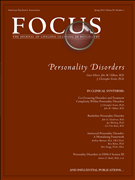Personality Disorders in DSM-5 Section III
Abstract
Problems with the DSM-IV’s exclusively categorical approach to personality disorder diagnosis have been well-documented. These include extensive co-occurrence; extreme heterogeneity within personality disorder categories; criteria made up of inconsistent amalgams of impairments, traits, and symptomatic behaviors; temporal instability of diagnoses at rates incompatible with the basic definition of personality disorder; arbitrary diagnostic thresholds with little or no empirical basis; poor coverage of personality pathology; poor convergent validity; and limited predictive validity and clinical utility. Furthermore, the General Criteria for Personality Disorder (GCPD) were introduced in DSM-IV without justification or indication of any empirical basis; they do not appear to be specific to personality disorders, as other chronic mental disorders are also likely to meet them, leading to problems in differential diagnosis. As a consequence of these myriad problems, DSM-IV personality disorder diagnoses have not been used (e.g., “Diagnosis Deferred on Axis II”), have been under-used (e.g., “Personality Disorder Not Otherwise Specified” [PD-NOS] is the most frequent diagnosis), or have been erroneously used (e.g., diagnoses often made on the basis of too few of the required criteria). Despite these long-recognized and significant shortcomings, however, the criteria for personality disorders in Section II of DSM-5 have not changed from those in DSM-IV.
A new approach to the diagnosis of personality disorders was developed for DSM-5, however, which can be found in Section III and is reproduced in this issue following this commentary. For the general criteria for personality disorder, a revised personality functioning criterion (Criterion A) was developed based on a literature review of reliable clinical measures of core impairments central to personality pathology and validated as specific for semistructured interview diagnoses of personality disorders in samples of over 2,000 patients and community subjects. Furthermore, the moderate level of impairment in personality functioning required for a personality disorder diagnosis in DSM-5 Section III was set empirically to maximize the ability of clinicians to identify personality disorder pathology accurately and efficiently. With a single assessment of level of personality functioning, a clinician can determine whether a full assessment for personality disorder is necessary.
The diagnostic criteria for specific DSM-5 personality disorders in the alternative model are consistently defined across disorders by typical impairments in personality functioning and by pathological personality traits that have been determined empirically to be characteristic of the personality disorders they represent. Diagnostic thresholds for both the A and the B criteria have been set empirically to minimize change in disorder prevalence and overlap with other personality disorders and to maximize relations with psychosocial impairment. A diagnosis of personality disorder—trait specified (PD-TS), based on moderate or greater impairment in personality functioning and the presence of pathological personality traits, replaces PD-NOS and provides a much more informative diagnosis for patients who are not optimally described as having a specific personality disorder. A greater emphasis on personality functioning and trait-based criteria increases the stability and empirical bases of the disorders.
Personality functioning and personality traits also can be assessed whether or not the individual has a personality disorder, providing clinically useful information about all patients. The DSM-5 Section III approach provides a clear conceptual basis for all personality disorder pathology and an efficient assessment approach with considerable clinical utility.



